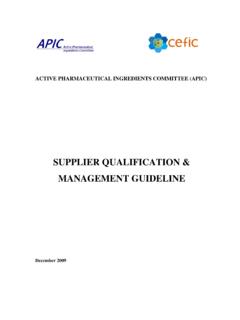Transcription of Evaluation Methods - United Nations
1 United Nations Procurement Division Evaluation Methods Lowest Responsive/Compliant/Acceptable Offer When using this method, the award of a contract should be made to the supplier whose offer has been evaluated and determined as both: a) responsive/compliant/acceptable, and b) offering the lowest price/cost. Responsive/compliant/acceptable can be defined as fully meeting the specifications/TOR/ SOW. required, or reaching a pre-defined threshold of a maximum attainable score based on the requirements stated in the specifications /TOR/SOW. The level of responsiveness/compliance/acceptability may be measured using straightforward pass/fail criteria or more complex approaches like a weighted scoring system.
2 There is a difference between price and cost. While price is the amount of money you pay to procure a certain product or service, cost is the amount of money you pay to operate the equipment over its lifetime or for the duration of a contract or project taking all price and related cost factors into account. The latter is also called the total cost of ownership (life cycle costing) . When applying the concept of lowest cost, cost means price plus other related cost factors such as freight cost, operational cost, cost of disposal, etc. Concepts like landed cost or lowest total cost of ownership (life cycle costing) fall under this category.
3 Landed Cost The calculation of hidden landed costs requires acknowledgement of the expenses necessary to purchase goods from one country and import them into another. Determining the total landed cost of an item involves three main elements: the actual cost of the goods, transportation and insurance costs, and all duties, taxes and governmental fees assessed on the goods. Lowest Total Cost of Ownership/Life Cycle Costing Lowest total cost of ownership considers several components of price quantified and tabulated over the life expectancy of the supply such as purchase price, operational costs, cost of disposal and other considerations.
4 The lowest responsive/compliant/acceptable offer is the simplest method of evaluating offers whereby non responsive/compliant/acceptable offers are rejected as soon as this becomes apparent. Among the remaining responsive/compliant/acceptable offers the lowest one is selected. This method may be used for procurement where: specifications/TOR/SOW are clear responsiveness/compliance/acceptability is easy to determine price/cost is the overriding Evaluation criterion compared to other aspects of value for money. Evaluation Methods United Nations 2009. Some examples are: Standard goods such as cars, Office equipment, Communication equipment, Chemicals, Simple machinery, or Raw materials, or For the procurement of services and works when the requirements can be quantitatively and qualitatively defined.
5 The lowest responsive/compliant/acceptable offer methodology consists of the following steps: Step Action 1 Determining which offers are responsive/compliant/acceptable, and reject non responsive/compliant/acceptable offers. Only bids offering goods/works/services meeting or exceeding the requirements in the specifications should be considered responsive/compliant/acceptable. 2 Choosing the lowest cost offer among the responsive/compliant/acceptable offers. Normally, a one-envelope system where Suppliers submit one offer including all technical and financial information is used when applying this method of Evaluation .
6 However, a two-envelope method where technical and financial offers are sealed separately may also be used if it is deemed necessary to complete the technical Evaluation without knowing the price of the respective offers, typically when responsiveness/compliance/acceptance is determined by a minimum threshold (point system). Weighted scoring method When using the weighted scoring method, the award of a contract should be made to the supplier whose offer has been evaluated and determined as: a) responsive / compliant / acceptable, and b) having received the highest score out of a pre-determined set of weighted technical and financial criteria specific to the solicitation.
7 This method may be used for more complex procurement where: Evaluation criteria cannot easily be quantified Different aspects of value for money ( price and quality) need to be considered and balanced Different types of scales need to be used for the various factors. The weighted scoring method is typically used for procurement of services, where the relative importance of each Evaluation criterion needs to be weighted. It can also be used for the Evaluation of offers for complex goods and works requiring the Evaluation to be based on a number of criteria other than price in order to ensure best value for money, and where it is difficult to evaluate an offer on the compliant/non-compliant scale, only.
8 Under this Evaluation method, price is rendered as one of the Evaluation criteria. In general, the more complex the requirement, the more significant the end product, and the less comparable the proposals, the less influence price should have on the selection, and the points allocated to the financial offer would be lower. For more straightforward requirements, price can play a significant Evaluation Methods United Nations 2009. part in the selection process, provided that the other criteria are also met. The total number of points allocated for the technical offer is normally higher than the total number of points allocated to the financial offer.
9 This way the risk of selecting a non-performing supplier is reduced, and the saving achieved by selecting the lower priced offer is not outweighed by the implications caused by a non- performing supplier . Thus, the financial offer is typically given between 15 and 50 percent importance. Financial Offer The financial offer should be opened only for those proposals where the technical Evaluation scores above a stated threshold, usually above 60 percent of the points allocated to the technical offer. For those proposals where the technical offer does not reach the minimum specified score, the corresponding financial offer is not eligible for further consideration, and the financial offer should be returned to the supplier unopened, accompanied by a letter notifying the supplier .
10 The maximum number of points allocated to the financial offer is given to the lowest priced proposal. All other financial offers receive points in inverse proportion, according to the following formula: p = y /z where: p = points for the financial offer being evaluated y = maximum number of points for the financial offer = price of the lowest priced proposal z = price of the proposal being evaluated The proposal obtaining the overall highest score after adding the score of the technical offer and the financial offer is the proposal that offers best value for money. Some disadvantages of weighted scoring Methods are: Time consuming decision factors and Evaluation scales must be developed, and each alternative must be compared against each Evaluation scale.















